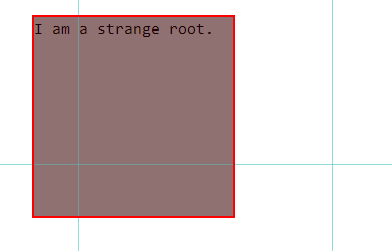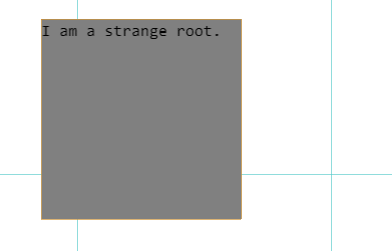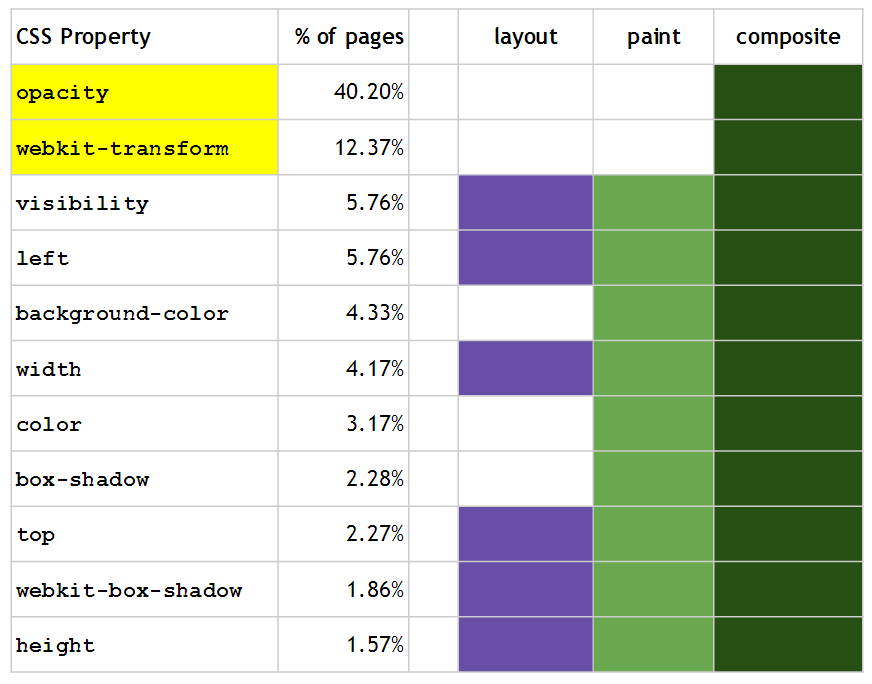标签:一个 latex 兼容 duration 设置 disable offset 计算 layout
webkit-transform: translateX(3em) 的方案代替使用 left: 3em ,因为left会额外触发layout与paint,而webkit-transform只触发整个页面composite
|
|
div {
-webkit-animation-duration: 5s;
-webkit-animation-name: move;
-webkit-animation-iteration-count: infinite;
-webkit-animation-direction: alternate;
width: 200px;
height: 200px;
margin: 100px;
background-color: #808080;
position: absolute;
}
|
|
|
@-webkit-keyframes move{
from {
left: 100px;
}
to {
left: 200px;
}
}
|
如下图使用left将持续触发页面重绘,表现为红色边框:

|
@-webkit-keyframes move{
from {
-webkit-transform: translateX(100px);
}
to {
-webkit-transform: translateX(200px);
}
}
|
附:《[韩顺平]轻松搞定网页设计(html+css+js)》 http://www.gooln.com/dir/16908.html
如下图使用-webkit-transform页面只发生重组,表现为橙色边框:


高性能移动Web相较PC的场景需要考虑的因素也相对更多更复杂,我们总结为以下几点: 流量、功耗与流畅度。 在PC时代我们更多的是考虑体验上的流畅度,而在Mobile端本身丰富的场景下,需要额外关注对用户基站网络流量使用的情况,设备耗电量的情况。
关于流畅度,主要体现在前端动画中,在现有的前端动画体系中,通常有两种模式:JS动画与CSS3动画。 JS动画是通过JS动态改写样式实现动画能力的一种方案,在PC端兼容低端浏览器中不失为一种推荐方案。 而在移动端,我们选择性能更优浏览器原生实现方案:CSS3动画。
然而,CSS3动画在移动多终端设备场景下,相比PC会面对更多的性能问题,主要体现在动画的卡顿与闪烁。
目前对提升移动端CSS3动画体验的主要方法有几点:
|
|
-webkit-transform: translate3d(0, 0, 0);
-moz-transform: translate3d(0, 0, 0);
-ms-transform: translate3d(0, 0, 0);
transform: translate3d(0, 0, 0);
|
如动画过程有闪烁(通常发生在动画开始的时候),可以尝试下面的Hack:
|
|
-webkit-backface-visibility: hidden;
-moz-backface-visibility: hidden;
-ms-backface-visibility: hidden;
backface-visibility: hidden;
-webkit-perspective: 1000;
-moz-perspective: 1000;
-ms-perspective: 1000;
perspective: 1000;
|
如下面一个元素通过translate3d右移500px的动画流畅度会明显优于使用left属性:
|
|
#ball-1 {
transition: -webkit-transform .5s ease;
-webkit-transform: translate3d(0, 0, 0);
}
#ball-1.slidein {
-webkit-transform: translate3d(500px, 0, 0);
}
#ball-2 {
transition: left .5s ease;
left: 0;
}
#ball-2.slidein {
left: 500px;
}
|
注:3D变形会消耗更多的内存与功耗,应确实有性能问题时才去使用它,兼在权衡
box-shadows与gradientsbox-shadows与gradients往往都是页面的性能杀手,尤其是在一个元素同时都使用了它们,所以拥抱扁平化设计吧。
|
position: fixed;
position: absolute;
|
我们从实例开始描述这个主题:
|
var newWidth = aDiv.offsetWidth + 10;
aDiv.style.width = newWidth + ‘px‘;
var newHeight = aDiv.offsetHeight + 10;
aDiv.style.height = newHeight + ‘px‘;
var newWidth = aDiv.offsetWidth + 10;
var newHeight = aDiv.offsetHeight + 10;
aDiv.style.width = newWidth + ‘px‘;
aDiv.style.height = newHeight + ‘px‘;
|
这是两段能力上完全等同的代码,显式的差异正如我们所见,只有执行顺序的区别。但真是如此吗?下面是加了说明注释的代码版本,很好的阐述了其中的进一步差异:
|
// 触发两次 layout
var newWidth = aDiv.offsetWidth + 10; // Read
aDiv.style.width = newWidth + ‘px‘; // Write
var newHeight = aDiv.offsetHeight + 10; // Read
aDiv.style.height = newHeight + ‘px‘; // Write
// 只触发一次 layout
var newWidth = aDiv.offsetWidth + 10; // Read
var newHeight = aDiv.offsetHeight + 10; // Read
aDiv.style.width = newWidth + ‘px‘; // Write
aDiv.style.height = newHeight + ‘px‘; // Write
|
从注释中可找到规律,连续的读取offsetWidth/Height属性与连续的设置width/height属性,相比分别读取设置单个属性可少触发一次layout。
从结论看似乎与执行队列有关,没错,这是浏览器的优化策略。所有可触发layout的操作都会被暂时放入 layout-queue 中,等到必须更新的时候,再计算整个队列中所有操作影响的结果,如此就可只进行一次的layout,从而提升性能。
关键一,可触发layout的操作,哪些操作下会layout的更新(也称为reflow或者relayout)?
我们从浏览器的源码实现入手,以开源Webkit/Blink为例, 对layout的更新,Webkit 主要通过 Document::updateLayout 与Document::updateLayoutIgnorePendingStylesheets 两个方法:
|
|
void Document::updateLayout()
{
ASSERT(isMainThread());
FrameView* frameView = view();
if (frameView && frameView->isInLayout()) {
ASSERT_NOT_REACHED();
return;
}
if (Element* oe = ownerElement())
oe->document()->updateLayout();
updateStyleIfNeeded();
StackStats::LayoutCheckPoint layoutCheckPoint;
if (frameView && renderer() && (frameView->layoutPending() || renderer()->needsLayout()))
frameView->layout();
if (m_focusedNode && !m_didPostCheckFocusedNodeTask) {
postTask(CheckFocusedNodeTask::create());
m_didPostCheckFocusedNodeTask = true;
}
}
void Document::updateLayoutIgnorePendingStylesheets()
{
bool oldIgnore = m_ignorePendingStylesheets;
if (!haveStylesheetsLoaded()) {
m_ignorePendingStylesheets = true;
HTMLElement* bodyElement = body();
if (bodyElement && !bodyElement->renderer() && m_pendingSheetLayout == NoLayoutWithPendingSheets) {
m_pendingSheetLayout = DidLayoutWithPendingSheets;
styleResolverChanged(RecalcStyleImmediately);
} else if (m_hasNodesWithPlaceholderStyle)
recalcStyle(Force);
}
updateLayout();
m_ignorePendingStylesheets = oldIgnore;
}
|
从 updateLayoutIgnorePendingStylesheets 方法的内部实现可知,其也是对 updateLayout 方法的扩展,并且在现有的 layout 更新模式中,大部分场景都是调用 updateLayoutIgnorePendingStylesheets 来进行layout的更新。
标签:一个 latex 兼容 duration 设置 disable offset 计算 layout
原文地址:http://www.cnblogs.com/linzenews/p/7064817.html